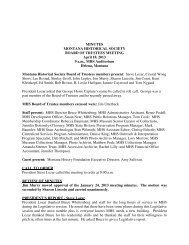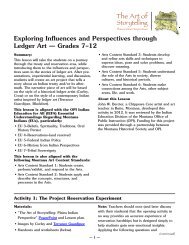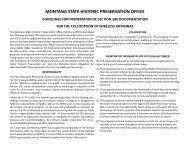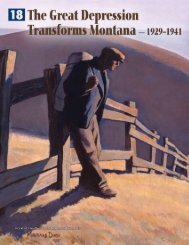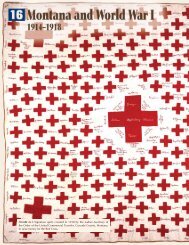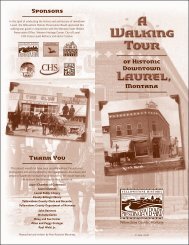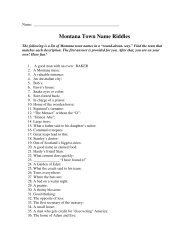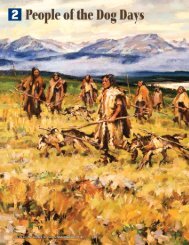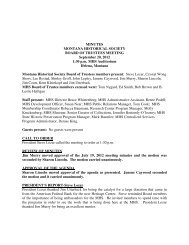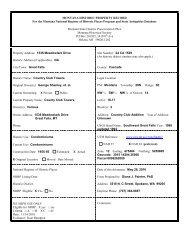Chapter 11 - Montana Historical Society
Chapter 11 - Montana Historical Society
Chapter 11 - Montana Historical Society
Create successful ePaper yourself
Turn your PDF publications into a flip-book with our unique Google optimized e-Paper software.
FIGURE <strong>11</strong>.2: Confi ned to reservations<br />
and facing an unknown future, families<br />
like this one on the Crow Reservation<br />
wondered what was ahead for their<br />
children.<br />
2 1 0 P A R T 2 : A C E N T U R Y O F T R A N S F O R M A T I O N<br />
The Bison Era Comes to an End<br />
In 1881 Sitting Bull—who had helped lead the Sioux during the Battle of<br />
the Little Bighorn—returned from Canada, where he and his band had<br />
fl ed at the end of the Great Sioux War. Returning to the United States<br />
meant surrendering to the U.S. Army. Sitting Bull did not want to give<br />
up his freedom, but his people were starving. The buffalo were gone.<br />
Even smaller game animals were hard to fi nd.<br />
On the day of his surrender, he gave his eight-year-old son, Crowfoot,<br />
his gun to turn over to the commanding offi cer. Then he said, “The boy<br />
has given it to you, and he now wants to know how he is going to<br />
make a living.”<br />
The question of how to make a living haunted all of <strong>Montana</strong>’s<br />
Indians in the early reservation era.<br />
Starvation Winter: Trading More Land for Food<br />
For most of the 1870s, <strong>Montana</strong>’s tribes continued to live primarily on<br />
the game and plants they harvested, just as their ancestors had for generations.<br />
They depended very little on annuities (annual payments of<br />
food, equipment, supplies, and funds the U.S. government owed a tribe<br />
by treaty).<br />
But by 1880 the bison were nearly gone, the population of settlers had<br />
boomed, and there was little game to hunt. The Blackfeet, Gros Ventre,<br />
Sioux, and Assiniboine—who lived on a large reservation covering much<br />
of northern <strong>Montana</strong>—increasingly depended on government annuities<br />
for survival. These annuities<br />
were not charity; they<br />
were payments for land<br />
(see <strong>Chapter</strong> 7). Yet despite<br />
its treaty agreements,<br />
Congress reduced the<br />
amount of money it was<br />
willing to spend on annuities.<br />
For several years<br />
there was not enough food<br />
to get people through the<br />
winter.<br />
In 1883 winter storms<br />
came early. The few provisions<br />
that the government<br />
did send to the<br />
northern tribes were held<br />
up by early snows. Finally,<br />
in December, a wagonload<br />
of bacon arrived at



